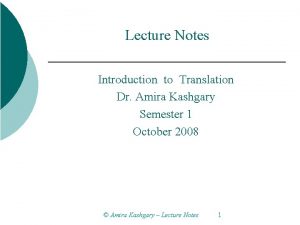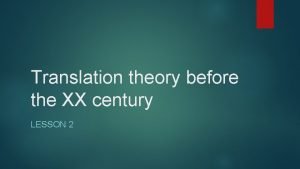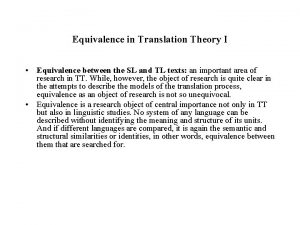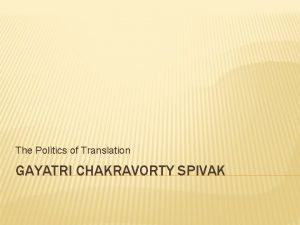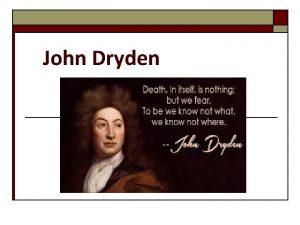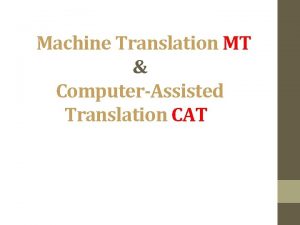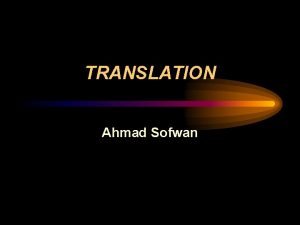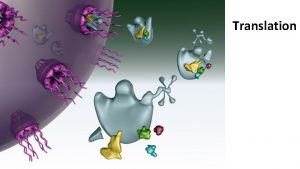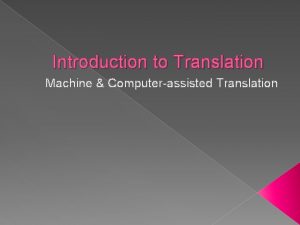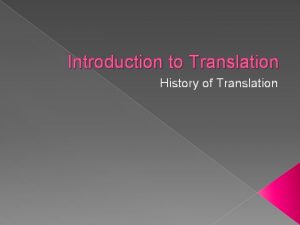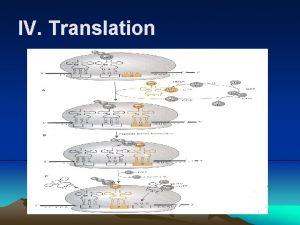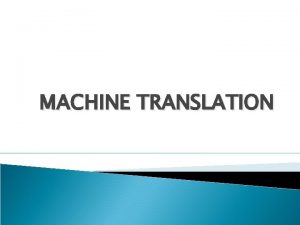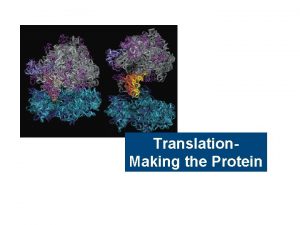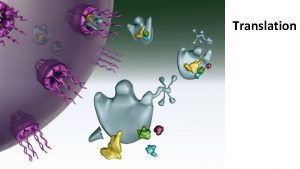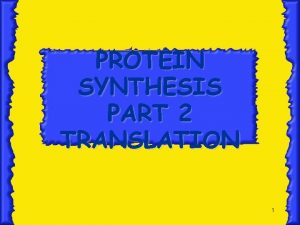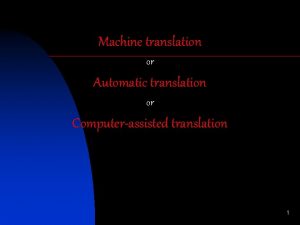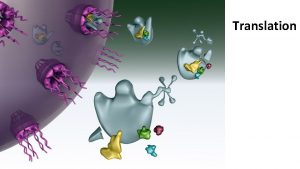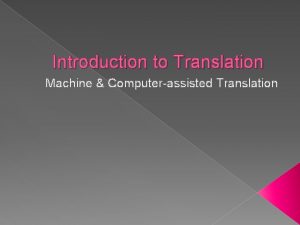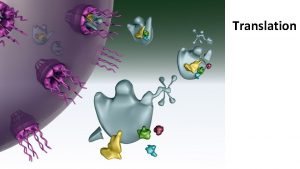Lecture 1 Translation and Theory of Translation 1

















- Slides: 17

Lecture 1. Translation and Theory of Translation. 1. Translation as a Notion. 2. Translation as a Science. 3. Basic Concepts of Translation Studies. 4. Types of Translation 5. History of Translation. Famous Translators

1. Translation as a notion. The word "translation" refers to two different concepts: • 1) translation as a kind of intellectual activity, • 2) translation as a result of this process, i. e. the text created by the translator. Translation is an activity that involves variational decoding of a text in one language into a text in another language, an activity performed by an interpreter who creatively chooses options depending on: the resources of the language, the type of translation, the translation tasks, the text type and under the influence of his own individuality. Translation is also the result of this activity. (Larysa Mykhailivna Alekseeva, 2006)

The users of translation identify it with the original text in three main aspects: Functionally Structurally The translation is to There should be belong to the same no change in the functional style as the sequence of original text. narration or in the arrangement of the segments of the text. Semantically The translation has the same meaning as the original text. No exchange of information is possible in the process of translation. The level of semantic identity between the original text and translation depends on degrees of translational equivalence. The translator usually tries to produce in translation the closest possible equivalent to the original text.

The main task of the translation is to convey the information contained in the original. There are 3 basic types of information: 1. cognitive (factual) information - objective information about the surrounding world; 2. emotional (expressive) information contains a message about human emotions; 3. operational information – contains information that encourages people to certain actions.

The process of translation consists of three stages: 1. analysis of the source text, situation and background information; 2. synthesis of the translation model; 3. verification of the model against the source and target context (semantic, grammatical, stylistic), situation, and background information resulting in the generation of the final target text. E. g. At the first stage the chips are put on the conveyer".

2. Translation as a Science. 1. The theory of equivalence “The student is reading a book”. – «Студент читає книгу» . 2. The general theory of translation within which there are three main approaches: • Transformational approach • Denotative approach • Communicational approach

3. Basic concepts of translation studies. • Sender of translation (author) – the person who generates the text in the original language. • Recipient of translation – the person for whom the translation is intended. • The original (source) text – the text that is being translated. • The translation (the target, resulting text) –the text that emerges as a result of the translation activity. • Interpreter is a person who speaks two or more languages and performs decoding of the information contained in the original into another language known by the Recipient.

• The source language – any natural language in the signs of which the source text is encoded. • The target language (the language of translation) – any natural language, used to decode the original. • Communicative effect – the property of the translation to cause the same effect on the recipient as that of the original. • The Unit of Translation (according to Roger Bell) – is the smallest segment of a source language text which can be translated, as a whole, in isolation from other segments (as small as possible and as large as necessary).

4. Types of Translation. 1. According to the type of the target and source languages: • intralingual translation • interlingual translation 2. According to the subject of translation activity: • traditional • machine translation • mixed translation.

3. By the type of translation units: • morpheme-by-morpheme translation • word-by-word translation • phrase-by-phrase translation; • sentence-by-sentence translation; • full-text translation 4. On the basis of the form of presentation: • written translation; • oral translation: 1) simultaneous interpretation 2) consecutive interpreting

5. According to the level of correspondence between the source and target texts: • free translation • interpretation • accurate translation • authentic translation

6. According to the style of the text: • scientific and technical translation; • social and political translation; • translation of fiction; • military translation; • legal translation; • colloquial translation. 7. According to the completeness of the target text: • complete translation • shortened translation

5. History of translation. Famous Translators. The main stages of the translation theory development: I. The early stage ancient Carthage ancient Rome II. From the end of the ancient period to the end of the XIX-th century III. Modern stage – from the beginning of the XX -th century till nowadays

St. Jerome (347 -420 AD) St. Jerome made a mistake in translating the Hebrew “keren” as “grew horn” instead of “radiated light. ” This lead to photos of Moses with horns on his head instead of radiating light.

Constance Garnett (1861 -1946) Garnett became famous for her Russian literature translations. Works included Chekhov, Tolstoy, and Dostoyevsky. Garnett translated 71 volumes of Russian literature.

Victor Petrovich Golyshev A Russian translator of Anglo-American literature. His translations of George Orwell, Truman Capote, William Faulkner, Francis Scott Fitzgerald, Charles Bukowski are considered to be of the highest quality.

Leonid Volodarsky The author of numerous translations of English and American fiction, including first translations of Stephen King into Russian. A famous translator of American films
 01:640:244 lecture notes - lecture 15: plat, idah, farad
01:640:244 lecture notes - lecture 15: plat, idah, farad Translation studies notes
Translation studies notes Communicative theory of translation
Communicative theory of translation Transformations of functions
Transformations of functions Natural language processing
Natural language processing Decision theory lecture notes
Decision theory lecture notes Sargur srihari
Sargur srihari Natural language processing nlp - theory lecture
Natural language processing nlp - theory lecture Voice translation rules
Voice translation rules Semantic translation và communicative translation
Semantic translation và communicative translation What is text linguistics
What is text linguistics Cicero translation theory
Cicero translation theory Equivalence examples in translation
Equivalence examples in translation Spivak translation theory
Spivak translation theory John dryden metaphrase paraphrase imitation
John dryden metaphrase paraphrase imitation Tamara berg husband
Tamara berg husband Theory of translation lectures
Theory of translation lectures Theory of translation lectures
Theory of translation lectures

